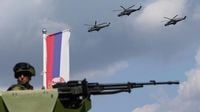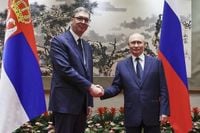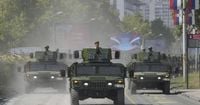Serbia is facing its most turbulent period in a quarter of a century as President Aleksandar Vucic intensifies a crackdown on a wave of protests that have rocked his populist rule. What began as a small, student-led movement against corruption has swelled into a nationwide outcry, exposing deep fissures in the Balkan nation’s political fabric and testing the president’s decade-long grip on power.
The unrest traces its roots to a tragic event on November 1, 2024, when a canopy collapsed at the railway station in Novi Sad, killing at least 16 people. The accident, linked to a Chinese-backed renovation project, ignited public outrage over alleged state-run corruption and negligence. University students, the first to respond, began blocking traffic every Friday for 15 minutes in memory of the dead. Their simple act of remembrance quickly transformed into a powerful symbol of defiance against what many saw as a culture of impunity among Serbia’s ruling elites.
According to the Associated Press, the protests soon spread beyond campuses, drawing in ordinary citizens frustrated with rising living costs and what they describe as an unaccountable government. Demonstrators’ demands have grown to include greater accountability, transparency, and—most urgently—early elections. This movement, described by rights groups as the largest challenge to Vucic’s authority in years, has now reached dozens of cities and small towns across the country.
At first, the demonstrations were marked by peaceful marches and sit-ins. But as the crowds grew, authorities responded with increasing force. Riot police, plainclothes officers, and even parapolice units led by soccer hooligans loyal to Vucic were deployed to disperse gatherings using batons, sticks, flares, tear gas, stun grenades, and sonic devices. Protesters have reported beatings, arbitrary arrests, and what human rights organizations have condemned as brutal and excessive tactics. Each new crackdown has only fueled further defiance, with students escalating their actions by blocking major intersections, occupying university halls, and staging sit-ins outside state institutions.
Last week, tanks rolled through the streets of Belgrade in preparation for a military parade scheduled for September 20, 2025. The display of military might has stoked fears among protesters that the armed forces could remain on the streets if unrest flares during the parade. The government’s show of force comes as Vucic, under mounting domestic pressure, has sought to project an image of stability and control.
President Vucic’s political journey has been as complex as Serbia’s recent history. He began his career in the 1990s as a hardline nationalist in the Serbian Radical Party, serving as information minister under Slobodan Milosevic, the late strongman ousted by mass protests in 2000. Vucic was notorious for calls to punish independent media and for his wartime rhetoric against Serbia’s neighbors—views he has not entirely abandoned. Following Serbia’s defeat in the Balkan wars, he reinvented himself as a pro-European reformer, co-founding the Serbian Progressive Party and promising modernization and EU integration. Yet, critics say he has consolidated power through populism, media control, and a tight grip on state institutions.
In recent months, Vucic has branded the student protesters as "terrorists" collaborating with Western powers to remove him from office, though he has offered no evidence to support the claim. While he has called for dialogue, he has steadfastly refused to call early elections and has warned of even harsher measures if the protests persist. Students, for their part, have flatly rejected any talks before elections are announced.
The government’s response to the unrest has extended into the education sector. More than 100 teachers, professors, and deans have been sacked and replaced with Vucic loyalists. Some schools have reopened with new staff, but others, particularly university faculties, remain closed. This heavy-handed approach has only deepened the sense of crisis, as many see it as an attack on academic freedom and independent thought.
Meanwhile, Vucic continues to walk a diplomatic tightrope on the international stage. On September 1, 2025, he attended a summit with leaders from China, Russia, North Korea, and Iran, where he claimed to have received their support in dealing with the protests. While refusing to join international sanctions against Russia for its invasion of Ukraine, Vucic has also not blocked Serbian exports of weapons to Ukraine. Earlier in 2025, he made his first-ever visit to Kyiv, signaling a willingness to engage with Western-aligned nations. Serbia has been a candidate for European Union membership since 2012, but negotiations have been slow, hampered by concerns over the country’s democratic trajectory.
Vucic’s tenure has been marked by the centralization of power, suppression of dissent, and tight media control. He has openly advocated the closure of the last remaining independent TV outlets, N1 and Nova, or a purge of their reporters and management. He has called these outlets liars for their coverage of the protests, even though their broadcasts have largely consisted of live, unfiltered footage. Human rights organizations and opposition groups argue that such actions threaten Serbia’s democratic institutions and press freedom.
European Union officials have warned that Serbia’s progress toward membership depends on reforms in the judiciary, media freedoms, and anti-corruption measures. However, the EU has so far shown little willingness to confront Vucic’s government directly. Some opposition figures and EU lawmakers argue that Europe’s response has been too timid, driven by fears that Vucic is the only leader capable of maintaining peace in a region still haunted by the wars of the 1990s, which claimed over 100,000 lives and displaced millions.
The stakes are high. The anti-graft rallies have evolved beyond a fight against corruption; they now represent a direct challenge to Vucic’s heavy-handed rule. Protesters are demanding not just free elections, but also an independent judiciary and accountability for police violence. With neither side showing signs of backing down, Serbia faces a deepening political crisis and the risk of further unrest—or even bloodshed.
As tanks roll through Belgrade and classrooms stand empty, the country finds itself at a crossroads. The coming weeks may determine whether Serbia moves closer to the European ideals it once aspired to, or slips further into authoritarianism and division.



